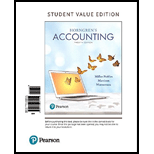
Concept explainers
Calculating materials and labor variances Learning Objective 3
DLEff. Var. $2,400 F
Matthews Fender, which uses a
Compute the cost and efficiency variances for direct materials and direct labor. Does the pattern of variances suggest Matthews Fender's managers have been making trade-offs? Explain.
Want to see the full answer?
Check out a sample textbook solution
Chapter 23 Solutions
Horngren's Accounting, Student Value Edition Plus MyLab Accounting with Pearson eText -- Access Card Package (12th Edition)
- What is the company's cost of goods manufactured for the year of this general accounting question?arrow_forwardExercise 2 Make an Excel spreadsheet to compute gross wages due each employee under federal wage-hour law. See notes below. Ryan is normally paid $1,000 for a 40-hour workweek. One week, he works 46 hours. 2.Latisha is normally paid $1,200 for a 40-hour workweek. One Monday she is out sick but receives 8 hours sick pay. She then works 40 hours Tuesday–Friday. 3. Al is normally paid $500 for a 40-hour workweek. One week, he works 45 hours. 4. Lee is normally paid $1,500 for a 40-hour workweek. To make up for leaving early one Friday, he works 44 hours this week.arrow_forwardHello tutor please provide this question solution general accountingarrow_forward
- Get accurate answer of this financial accounting questionarrow_forwardThe cost of goods sold isarrow_forwardRequired information [The following information applies to the questions displayed below.] Kitimat Company manufactures winter hats that sell for $42 per unit. The following information pertains to the company's first year of operations in which it produced 40,100 units and sold 37,600 units. Variable costs per unit: Manufacturing: Direct materials Direct labour Variable manufacturing overhead Variable selling and administrative Fixed costs per year: Fixed manufacturing overhead Fixed selling and administrative expenses 16 $ 16 $ $ 1 $ 2 $401,000 $247,000 9. What would have been the company's variable costing operating income if it had produced and sold 37,600 units?arrow_forward
- Required information [The following information applies to the questions displayed below.] Kitimat Company manufactures winter hats that sell for $42 per unit. The following information pertains to the company's first year of operations in which it produced 40,100 units and sold 37,600 units. Variable costs per unit: Manufacturing: Direct materials Direct labour Variable manufacturing overhead Variable selling and administrative Fixed costs per year: Fixed manufacturing overhead Fixed selling and administrative expenses $ 16 LA LA LA LA $ $ 6612 $401,000 $247,000 4. What is the company's operating income under variable costing?arrow_forwardDo fast answer of this general accounting questionarrow_forwardUsing the high-low method, estimate a cost formula for power cost. ??arrow_forward
 Cornerstones of Cost Management (Cornerstones Ser...AccountingISBN:9781305970663Author:Don R. Hansen, Maryanne M. MowenPublisher:Cengage Learning
Cornerstones of Cost Management (Cornerstones Ser...AccountingISBN:9781305970663Author:Don R. Hansen, Maryanne M. MowenPublisher:Cengage Learning Managerial AccountingAccountingISBN:9781337912020Author:Carl Warren, Ph.d. Cma William B. TaylerPublisher:South-Western College Pub
Managerial AccountingAccountingISBN:9781337912020Author:Carl Warren, Ph.d. Cma William B. TaylerPublisher:South-Western College Pub Managerial Accounting: The Cornerstone of Busines...AccountingISBN:9781337115773Author:Maryanne M. Mowen, Don R. Hansen, Dan L. HeitgerPublisher:Cengage Learning
Managerial Accounting: The Cornerstone of Busines...AccountingISBN:9781337115773Author:Maryanne M. Mowen, Don R. Hansen, Dan L. HeitgerPublisher:Cengage Learning


